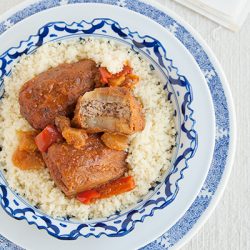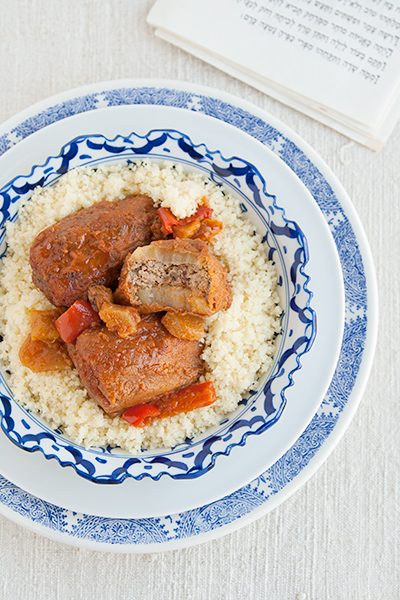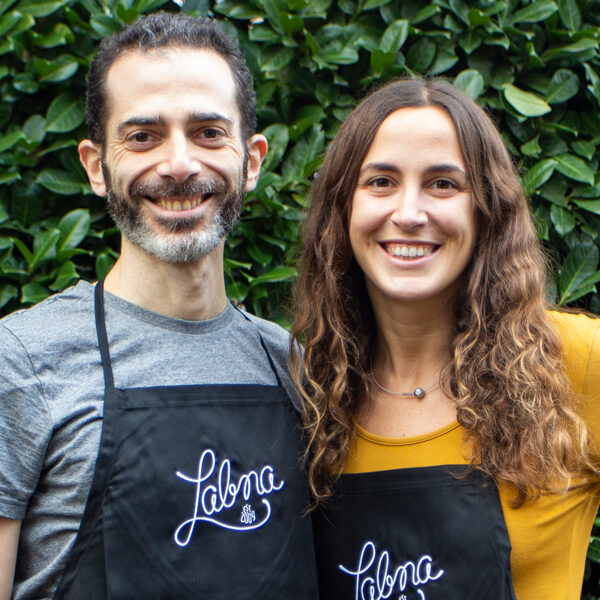Mafrum
This blog – which many of you know and love for its Jewish twist – recently celebrated its seventh year. Since 2009, we have published almost 700 recipes, many of which are typical of the Jewish Italian, Middle Eastern, and even Eastern European traditions, but we are guilty of never having shared the recipe for one of the most delicious and classic Jewish dishes from Tripoli, my dad’s hometown: Lybian mafrum.
Mafrum are stuffed vegetable patties, which are first fried, and then stewed in tomato sauce. As you can imagine, it is quite a labor-intensive dish to prepare, but is invariably loved by anyone who tries it. People go nuts for Libyan mafrum: once they try them, they will ask you to prepare them over and over again.
In my home, we prepare many Libyan dishes to celebrate Shabbat and the main Jewish festivals, such as hraimi, lubia, bestile, and nukides, but in my “culinary memory” family celebrations taste like mafrum. You can’t celebrate a holiday if you don’t have mafrum on the table.
Take a free afternoon and have fun cooking this elaborate, but absolutely amazing dish; I promise you, it will be worth it.

Libyan Mafrum
Ingredients
- 500 g ground beef
- 2 eggs for the filling
- ½ teaspoon cinnamon for the filling
- 1 finely ground onion for the filling
- 30-50 g breadcrumbs
- 1 teaspoon sweet paprika for the filling
- 1 small bunch parsley, chopped
- choice of vegetables to stuff: potatoes, eggplant, cauliflower, artichokes, onions
- 4 tbsp extra-virgin olive oil
- 1/2 teaspoon sweet paprika for the sauce
- 1 thinly sliced onion for the sauce
- 2 tbsp tomato concentrate for the sauce
- 3 eggs for breading before frying
- 5 tbsp all-purpose flour for dredging
- vegetable oil for frying
- salt and pepper to taste
Instructions
- Begin by assembling the filling. In a large bowl, mix beef, onion, eggs, parsley, spices, a generous pinch of salt, and breadcrumbs as needed to obtain a mixture that can easily be shaped into a ball. Once the filling is ready, move it into the refrigerator.500 g ground beef, 30-50 g breadcrumbs, 2 eggs for the filling, ½ teaspoon cinnamon for the filling, 1 teaspoon sweet paprika for the filling, 1 small bunch parsley, chopped, 1 finely ground onion for the filling
- Next, prepare the vegetables for stuffing. The simplest, most traditional, and most appreciated mafrum are those made with potatoes; so if this is the first time you try out this rather labor-intensive recipe, you should start with just potatoes, but of course, you can also use many other vegetables, such as eggplants, artichokes, cauliflowers, onions, etc.
- The principle is simple: you want to "butterfly" cut the potatoes (or other vegetables) so that inside the vegetable there is a "V" shaped groove to fill with the stuffing. For potatoes it's simple, all you have to do is peel them, cut them geometrically to get a kind of squared-off prism, and then cut into it with a knife (up to approximately ¾ of the potato) to get a groove. Another way to think about this is trying to make a "book" out of the vegetable.choice of vegetables to stuff: potatoes, eggplant, cauliflower, artichokes, onions
- As you cut the vegetables to get the recommended shape, set aside all the scraps that are left over from cutting: you will need these for the so-called "bottom" of the pot, the part of the dish that people will fight about.
- Once you butterfly the vegetables, fill them with the ground beef filling previously prepared, proceeding until all the ingredients are used.
- Now, onto dredging and frying. Prepare two bowls, one with the three lightly beaten eggs and one with all-purpose flour.3 eggs for breading before frying, 5 tbsp all-purpose flour for dredging
- Warm a deep frying pan with plenty of oil for frying; keep an eye on the oil temperature if you have a thermometer, or test the temperature with an apple slice or a piece of bread to make sure the oil is hot enough before you start frying.vegetable oil for frying
- Roll the stuffed vegetables in flour, trying to make the flour adhere well to the surface, then into the beaten egg. Lastly, transfer them directly into the frying pan. Fry a few vegetables at a time until they are nicely golden, carefully keeping the oil temperature constant.
- As the mafrum are ready, drain them on a tray covered with paper towels.
- We are not done yet. Now we need to cook those mafrum in tomato sauce. Separately, in a very large non-stick pot or a Dutch oven, sautée the thinly sliced onion in extra-virgin olive oil. When the onions are translucent, add the tomato concentrate diluted with a glass of water, the scraps of all the vegetables previously prepared, a pinch of salt, and ½ teaspoon of sweet paprika.4 tbsp extra-virgin olive oil, 1 thinly sliced onion for the sauce, 2 tbsp tomato concentrate for the sauce, salt and pepper to taste, 1/2 teaspoon sweet paprika for the sauce
- Place the fried mafrum in the pot with the sauce, making two layers if the size of the pot does not allow all the veggies to fit on the bottom in one layer.
- Throw in a pinch of salt and pepper, a bit of cinnamon, and cover with plenty of water, say another 300 ml.
- Stew the patties in the semi-covered pot, at low heat, for a good hour or until the sauce is reduced. You may want to extend the cooking further by adding more water to the patties. As with all the stews, a longer time in the pot ensures a more intense flavor.
- Serve the mafrum on a soft couscous bed, taking care to give each guest plenty of the sauce from the bottom of the pot.
- Do not forget to add some slices of lemon and black pepper to the table, so that guests can use them, if they like, to season their mafrum.




